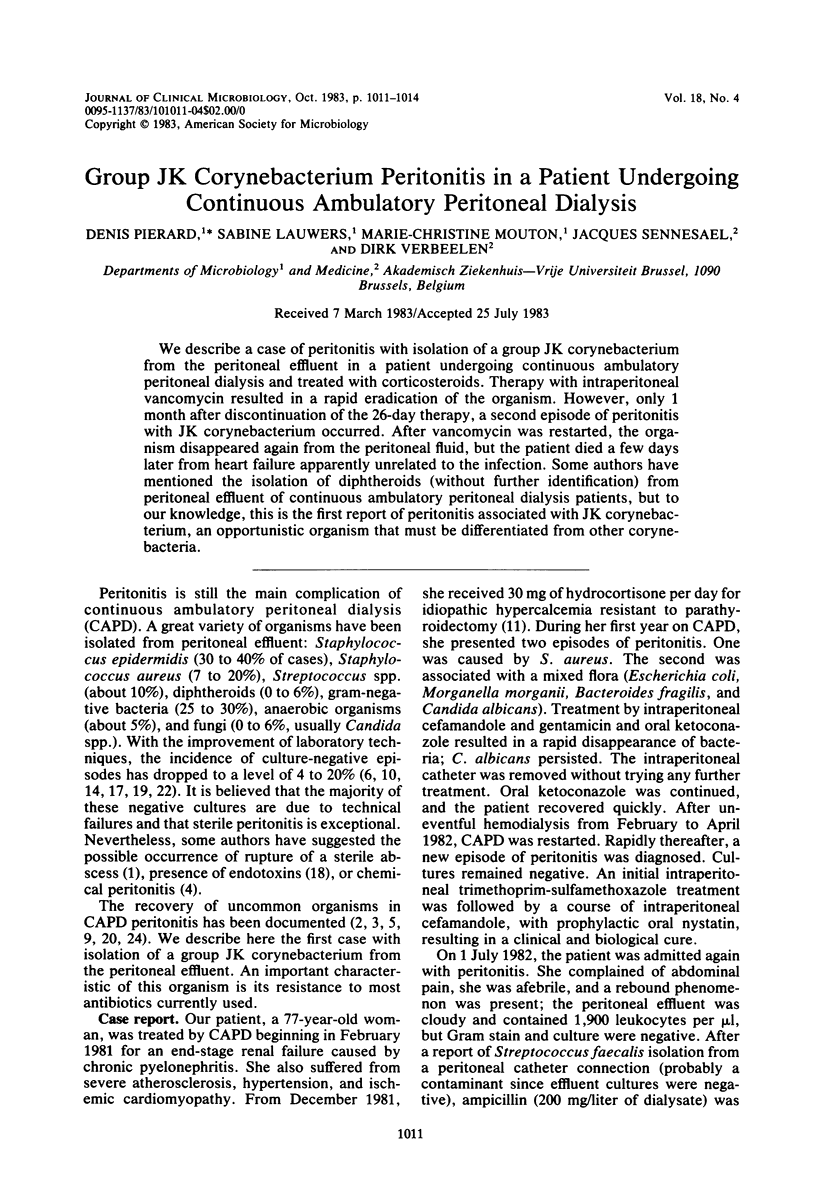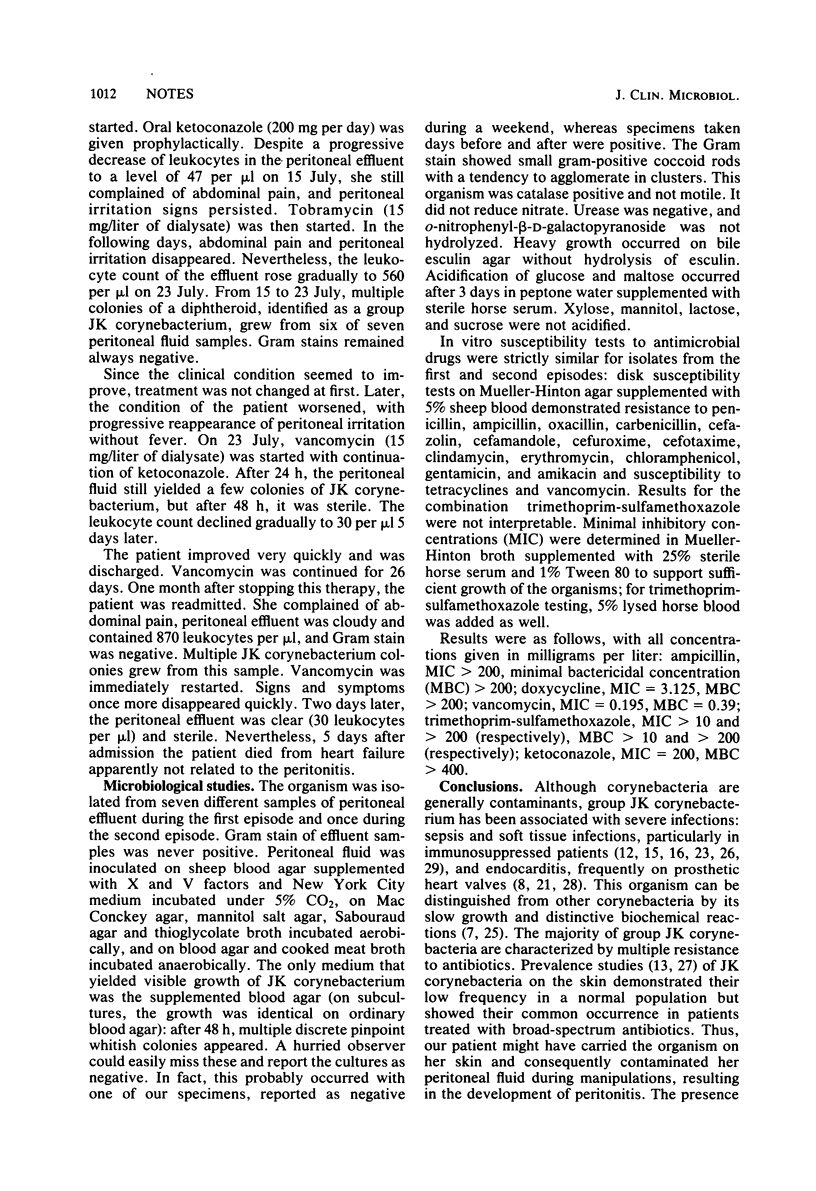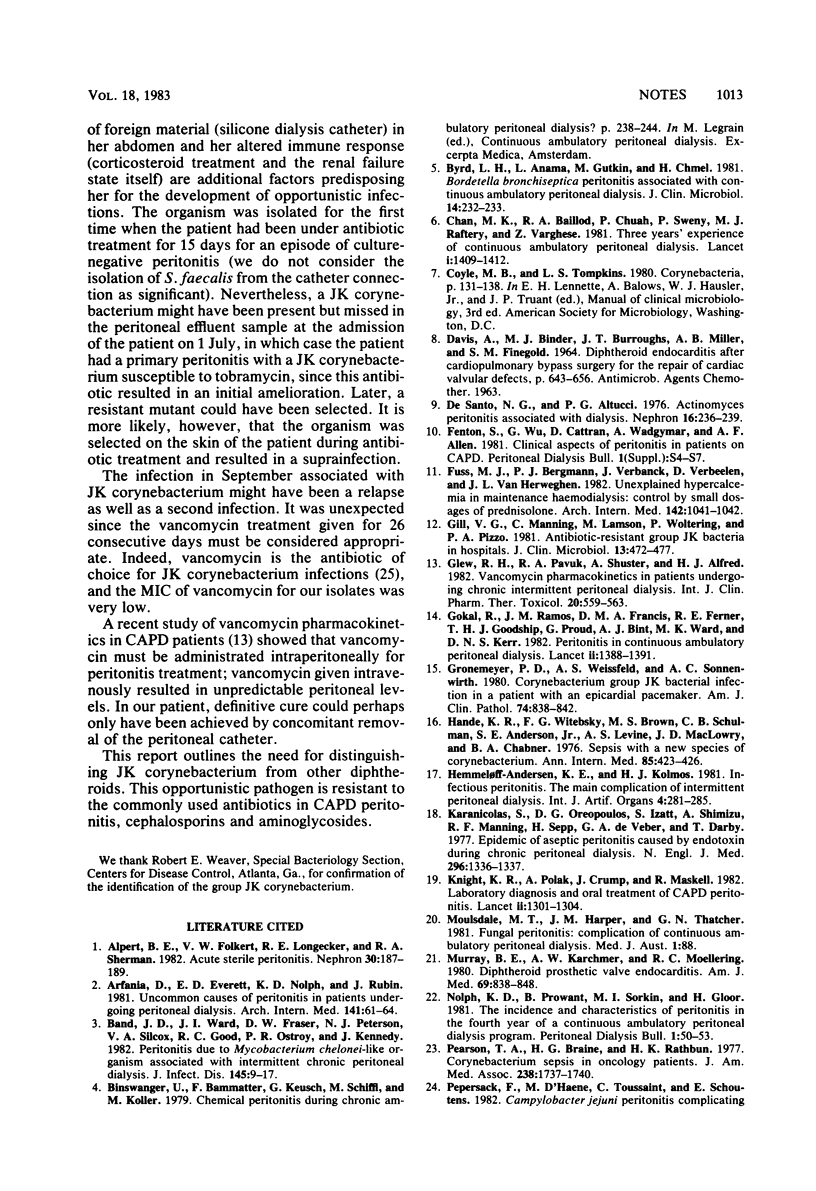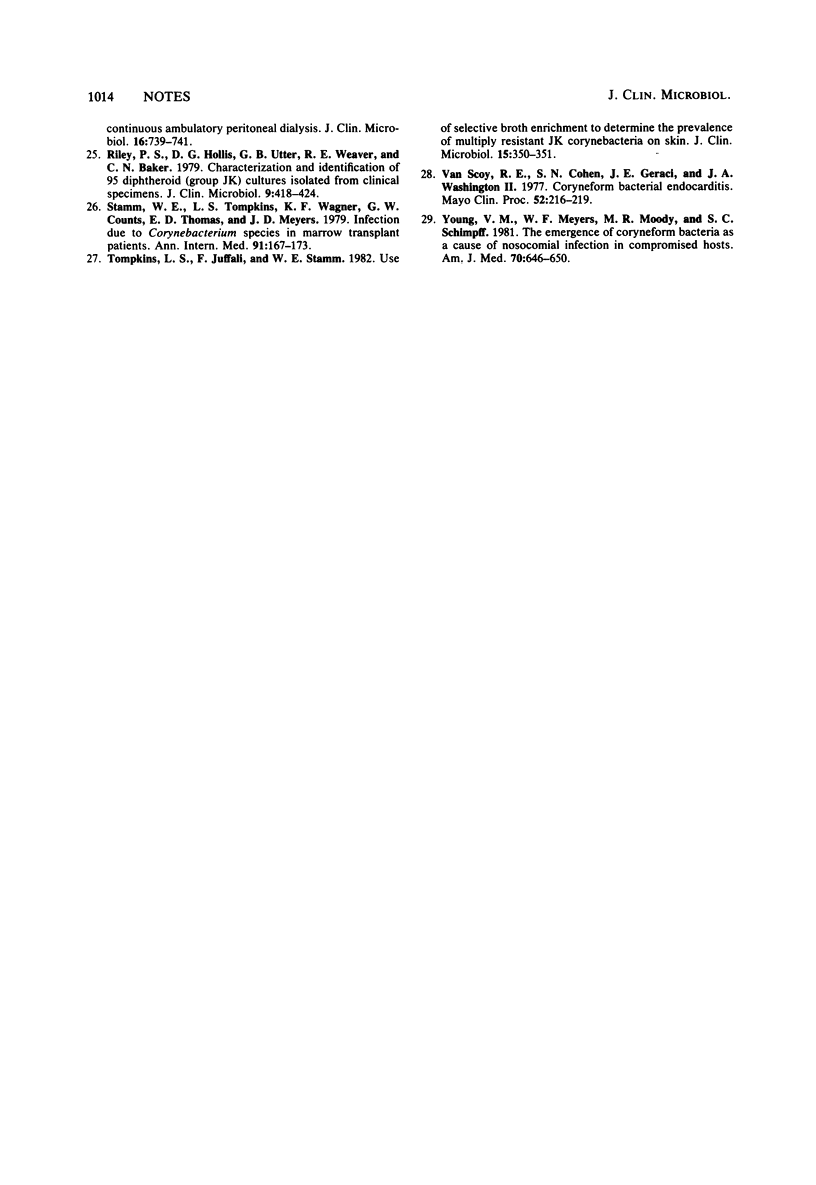Abstract
We describe a case of peritonitis with isolation of a group JK corynebacterium from the peritoneal effluent in a patient undergoing continuous ambulatory peritoneal dialysis and treated with corticosteroids. Therapy with intraperitoneal vancomycin resulted in a rapid eradication of the organism. However, only 1 month after discontinuation of the 26-day therapy, a second episode of peritonitis with JK corynebacterium occurred. After vancomycin was restarted, the organism disappeared again from the peritoneal fluid, but the patient died a few days later from heart failure apparently unrelated to the infection. Some authors have mentioned the isolation of diphtheroids (without further identification) from peritoneal effluent of continuous ambulatory peritoneal dialysis patients, but to our knowledge, this is the first report of peritonitis associated with JK corynebacterium, an opportunistic organism that must be differentiated from other corynebacteria.
Full text
PDF



Selected References
These references are in PubMed. This may not be the complete list of references from this article.
- Alpert B. E., Folkert V. W., Longnecker R. E., Sherman R. A. Acute sterile peritonitis. Nephron. 1982;30(2):187–189. doi: 10.1159/000182458. [DOI] [PubMed] [Google Scholar]
- Arfania D., Everett E. D., Nolph K. D., Rubin J. Uncommon causes of peritonitis in patients undergoing peritoneal dialysis. Arch Intern Med. 1981 Jan;141(1):61–64. doi: 10.1001/archinte.141.1.61. [DOI] [PubMed] [Google Scholar]
- Band J. D., Ward J. I., Fraser D. W., Peterson N. J., Silcox V. A., Good R. C., Ostroy P. R., Kennedy J. Peritonitis due to a mycobacterium chelonei-like organism associated with intermittent chronic peritoneal dialysis. J Infect Dis. 1982 Jan;145(1):9–17. doi: 10.1093/infdis/145.1.9. [DOI] [PubMed] [Google Scholar]
- Byrd L. H., Anama L., Gutkin M., Chmel H. Bordetella bronchiseptica peritonitis associated with continuous ambulatory peritoneal dialysis. J Clin Microbiol. 1981 Aug;14(2):232–233. doi: 10.1128/jcm.14.2.232-233.1981. [DOI] [PMC free article] [PubMed] [Google Scholar]
- Chan M. K., Baillod R. A., Chuah P., Sweny P., Raftery M. J., Varghese Z., Moorhead J. F. Three years' experience of continuous ambulatory peritoneal dialysis. Lancet. 1981 Jun 27;1(8235):1409–1412. doi: 10.1016/s0140-6736(81)92582-4. [DOI] [PubMed] [Google Scholar]
- De Santo N. G., Altucci P., Giordano C. Actinomyces peritonitis associated with dialysis. Nephron. 1976;16(3):236–239. doi: 10.1159/000180607. [DOI] [PubMed] [Google Scholar]
- Fuss M. J., Bergmann P. J., Verbanck-Taverne J., Verbeelen D. L., Vanherweghem J. L. Unexpected hypercalcemia in maintenance hemodialysis: control by small dosages of prednisolone. Arch Intern Med. 1982 May;142(5):1041–1042. [PubMed] [Google Scholar]
- Gill V. J., Manning C., Lamson M., Woltering P., Pizzo P. A. Antibiotic-resistant group JK bacteria in hospitals. J Clin Microbiol. 1981 Mar;13(3):472–477. doi: 10.1128/jcm.13.3.472-477.1981. [DOI] [PMC free article] [PubMed] [Google Scholar]
- Glew R. H., Pavuk R. A., Shuster A., Alfred H. J. Vancomycin pharmacokinetics in patients undergoing chronic intermittent peritoneal dialysis. Int J Clin Pharmacol Ther Toxicol. 1982 Dec;20(12):559–563. [PubMed] [Google Scholar]
- Gokal R., Ramos J. M., Francis D. M., Ferner R. E., Goodship T. H., Proud G., Bint A. J., Ward M. K., Kerr D. N. Peritonitis in continuous ambulatory peritoneal dialysis. Laboratory and clinical studies. Lancet. 1982 Dec 18;2(8312):1388–1391. doi: 10.1016/s0140-6736(82)91282-x. [DOI] [PubMed] [Google Scholar]
- Gronemeyer P. S., Weissfeld A. S., Sonnenwirth A. C. Corynebacterium group JK bacterial infection in a patient with an epicardial pacemaker. Am J Clin Pathol. 1980 Dec;74(6):838–842. doi: 10.1093/ajcp/74.6.838. [DOI] [PubMed] [Google Scholar]
- Hande K. R., Witebsky F. G., Brown M. S., Schulman C. B., Anderson S. E., Jr, Levine A. S., MacLowery J. D., Chabner B. A. Sepsis with a new species of Corynebacterium. Ann Intern Med. 1976 Oct;85(4):423–426. doi: 10.7326/0003-4819-85-4-423. [DOI] [PubMed] [Google Scholar]
- Hemmeløff Andersen K. E., Kolmos H. J. Infectious peritonitis. The main complication of intermittent peritoneal dialysis. Int J Artif Organs. 1981 Nov;4(6):281–285. [PubMed] [Google Scholar]
- Karanicolas S., Oreopoulos D. G., Izatt S., Shimizu A., Manning R. F., Sepp H., de Veber G. A., Darby T. Epidemic of aseptic peritonitis caused by endotoxin during chronic peritoneal dialysis. N Engl J Med. 1977 Jun 9;296(23):1336–1337. doi: 10.1056/NEJM197706092962309. [DOI] [PubMed] [Google Scholar]
- Knight K. R., Polak A., Crump J., Maskell R. Laboratory diagnosis and oral treatment of CAPD peritonitis. Lancet. 1982 Dec 11;2(8311):1301–1304. doi: 10.1016/s0140-6736(82)91509-4. [DOI] [PubMed] [Google Scholar]
- Moulsdale M. T., Harper J. M., Thatcher G. N. Fungal peritonitis: complication of continuous ambulatory peritoneal dialysis. Med J Aust. 1981 Jan 24;1(2):88–88. doi: 10.5694/j.1326-5377.1981.tb135333.x. [DOI] [PubMed] [Google Scholar]
- Murray B. E., Karchmer A. W., Moellering R. C., Jr Diphtheroid prosthetic valve endocarditis. A study of clinical features and infecting organisms. Am J Med. 1980 Dec;69(6):838–848. doi: 10.1016/s0002-9343(80)80009-x. [DOI] [PubMed] [Google Scholar]
- Pearson T. A., Braine H. G., Rathbun H. K. Corynebacterium sepsis in oncology patients. Predisposing factors, diagnosis, and treatment. JAMA. 1977 Oct 17;238(16):1737–1740. [PubMed] [Google Scholar]
- Riley P. S., Hollis D. G., Utter G. B., Weaver R. E., Baker C. N. Characterization and identification of 95 diphtheroid (group JK) cultures isolated from clinical specimens. J Clin Microbiol. 1979 Mar;9(3):418–424. doi: 10.1128/jcm.9.3.418-424.1979. [DOI] [PMC free article] [PubMed] [Google Scholar]
- Stamm W. E., Tompkins L. S., Wagner K. F., Counts G. W., Thomas E. D., Meyers J. D. Infection due to Corynebacterium species in marrow transplant patients. Ann Intern Med. 1979 Aug;91(2):167–173. doi: 10.7326/0003-4819-91-2-167. [DOI] [PubMed] [Google Scholar]
- Tompkins L. S., Juffali F., Stamm W. E. Use of selective broth enrichment to determine the prevalence of multiply resistant JK corynebacteria on skin. J Clin Microbiol. 1982 Feb;15(2):350–351. doi: 10.1128/jcm.15.2.350-351.1982. [DOI] [PMC free article] [PubMed] [Google Scholar]
- Van Scoy R. E., Cohen S. N., Geraci J. E., Washington J. A., 2nd Coryneform bacterial endocarditis: difficulties in diagnosis and treatment, presentation of three cases, and review of literature. Mayo Clin Proc. 1977 Apr;52(4):216–219. [PubMed] [Google Scholar]
- Young V. M., Meyers W. F., Moody M. R., Schimpff S. C. The emergence of coryneform bacteria as a cause of nosocomial infections in compromised hosts. Am J Med. 1981 Mar;70(3):646–650. doi: 10.1016/0002-9343(81)90589-1. [DOI] [PubMed] [Google Scholar]


